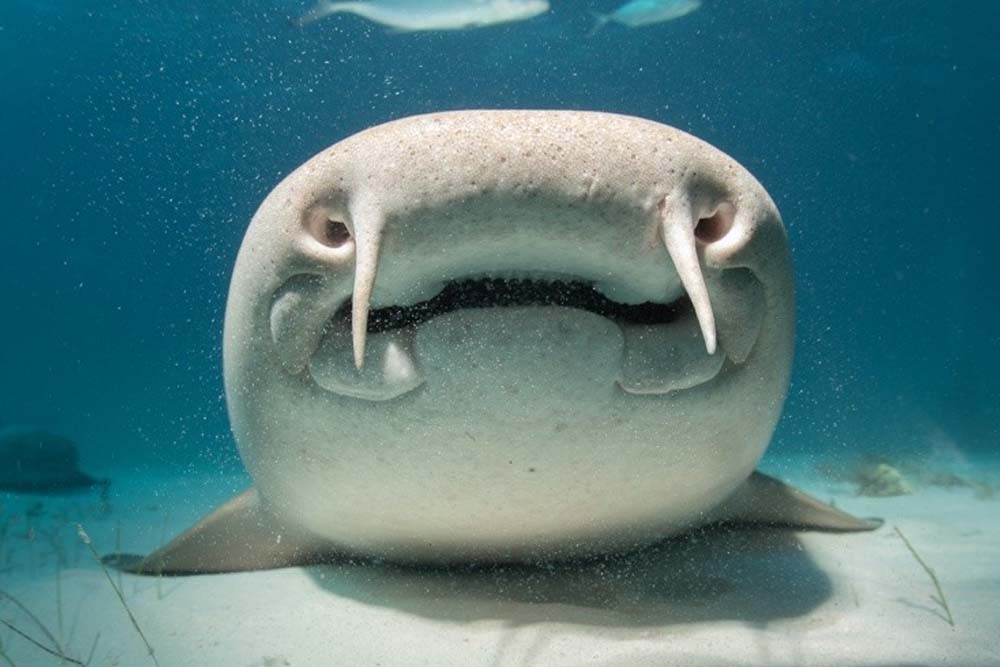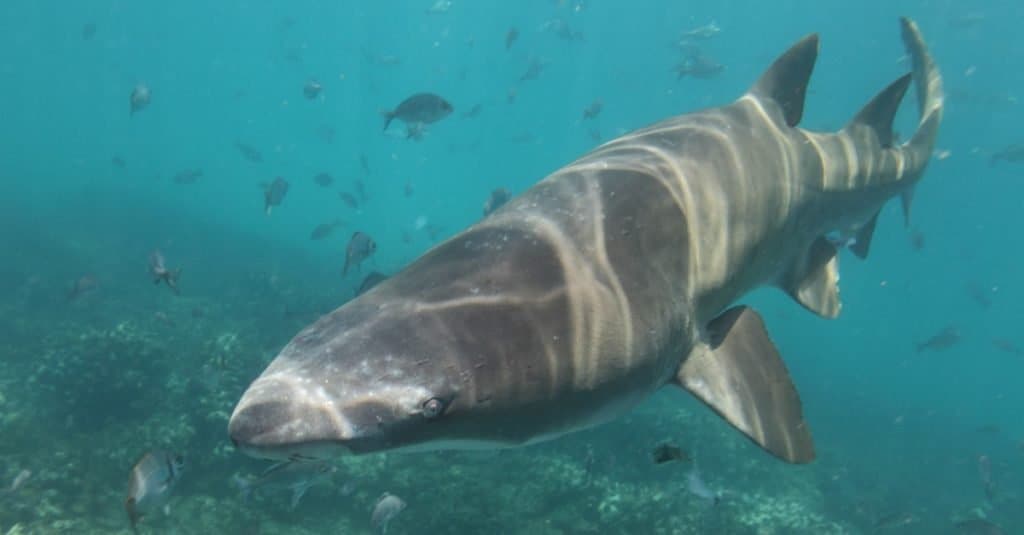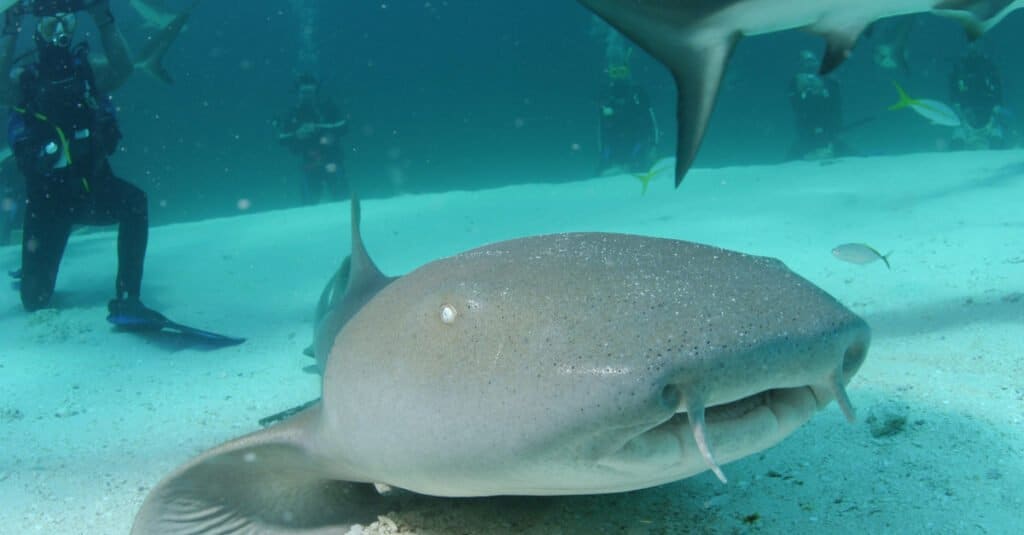Nurse sharks are nocturnal slow-moving fish species that often dwell on the bottom of warm coastal waters. Sleeper sharks, as they are sometimes called because of their sleeping habits, are brownish and have distinctive round bodies with broad heads, small snouts, and rectangular mouths. These sharks often grow between 7.5 to 9 feet (2.29-2.74 meters) and weigh 150 to 300 pounds (68.04-136.08 kilograms).
Nurse sharks can reach maximum lengths of 14 feet (4.27 meters), which is more than twice the average human’s height. Considering their size, just how dangerous or aggressive are they?
Are Nurse Sharks Aggressive?

One of the most harmless sharks in the world is the nurse shark.
©Maui Topical Images/Shutterstock.com
Nurse sharks are one of the most harmless sharks in the world. Besides their size and ‘savage’ tags, nurse sharks are easy-going animals. They move slowly and sleep for most of the daytime, earning them a mention among the world’s laziest animals. Nurse sharks feed on smaller prey, so they have no cause to attack humans who are larger than their usual prey.
Divers have interacted with nurse sharks and have petted them without losing their hands. Often, these sharks swim away from humans when approached. While it is relatively safe to swim close to a nurse shark, it is important not to provoke or hit them, as that could make them defensive.
Are Nurse Sharks Dangerous?

When provoked, nurse sharks could be dangerous.
©Alessandro De Maddalena/Shutterstock.com
Nurse sharks are not aggressive towards humans, but they are capable of causing damage to any human who threatens them. Their mouths are small, thus limiting the size of their bites, but like most sharks, they have incredibly sharp and strong teeth.
These saltwater predators have many rows of tiny serrated teeth with which they crush food and defend themselves. Their teeth set them apart from vicious sharks like the great white shark or the tiger shark, which have long needle teeth for piercing flesh. Nevertheless, a bite from a nurse shark can be quite dreadful.
Nurse sharks would not attack a human unless provoked. These large sharks are sometimes mistaken for more aggressive sharks because of their size and can be attacked by humans. If this occurs, the docile shark will defend itself but will not seek to kill its victim.
However, due to their small mouths, they may not be able to dislodge their teeth from their victim’s flesh once they clamp down. According to Florida Museum, surgery might be needed to unclamp the teeth of a nurse shark from its victim. This, of course, involves killing the shark first.
Has A Nurse Shark Ever Attacked A Human?

Nurse sharks are responsible for 52 provoked shark attacks and 5 unprovoked ones.
©tali de pablos/Shutterstock.com
Nurse sharks are non-aggressive sharks and hardly ever attack humans except provoked. Provoking a shark might seem farfetched, but with more people in coastal waters in recent years, attacks were bound to happen. According to reports, there have been 51 provoked nurse shark attacks and 5 unprovoked. Compared to the great white shark, the nurse shark has a very low attack rate on humans.
The probability of getting killed by a shark worldwide is 1-in-4,332,817, according to the ISAF. Thus, there’s a higher chance of dying from lightning, accidents, and dog bites than there is of getting killed by a shark, especially one as docile as the nurse shark.
Are Nurse Sharks Good As Pets?
Nurse sharks are rather friendly with humans. Nurse sharks do better in captivity than other sharks, making them one of the marine biologist’s best specimens. Unlike the hammerhead shark and other larger sharks, these nocturnal sharks are not migratory and do not need a very large aquarium to survive. Nurse sharks pick suitable resting places and return there every day after hunting. Also, their unique ability to sleep without the need for constant motion makes them more tolerant in captivity.
Nurse sharks live up to 25 years in captivity which is longer than they do in the open oceans, where they are prey to bigger sharks, alligators, and humans. In the United States, captured nurse sharks can be found in the National Aquarium, Point Defiance Zoo & Aquarium in Tacoma, and Omaha’s Zoo & Aquarium.
5 Facts About Nurse Sharks You Might Not Know
Listed below are five exciting facts about the nurse shark that you might not know.
1. Nurse sharks belong to the Ginglymostomatidae family
Nurse sharks belong to the Ginglymostomatidae family. The sharks that belong to their family are sluggish-moving and bottom dwellers. The Ginglymostomatidae family is made of 4 species split into three genera, with the nurse shark being the largest. The sharks in this family are also characterized by their small mouths, which are far ahead of their snouts and small eyes, and a tail that measures about a quarter of their body lengths.
2. Nurse sharks can reach 25 mph
Nurse sharks move slowly at the bottom of the ocean in a motion likened to walking, using their pectoral fins. Though these sharks are slow, they are capable of short bursts of speed, reaching about 25 miles per hour as nurse sharks hunt prey.
3. Nurse sharks include crustaceans and snails in their diet
Nurse sharks are opportunistic feeders who swim the bottom of their saltwater habitat in search of small prey to feed on. Though these distinctive shark species sleep in groups during the day, they hunt individually when they wake. The nurse shark’s small mouth is a restrictive factor in determining what prey they go after. Nurse sharks feed on animals such as crustaceans, octopi, and snails. Nurse sharks also eat small fish like grunts and stingrays.
These bottom feeders have very small eyes and two barbels with which they search out their prey. Nurse sharks do not dash and attack like many sharks; they suck their prey into their mouths and crush them with their teeth. When their prey is too large for their mouths, they shake their heads frantically to reduce the size of their food or suck and spit.
4. Nurse Sharks are present in the Eastern Pacific Ocean
Nurse sharks are considered species of least concern in the Bahamas and the United States. These sharks can be found in Eastern and Western Atlantic and the Eastern Pacific Ocean, stretching from Rhode Island to Brazil.
During the daytime, nurse sharks can be found motionless and at the bottom of the water surface in schools of other nurse sharks. The preferred habitats for nurse sharks are rocks, coral reefs, and crevices.
5. Nurse sharks taste like chicken
According to Florida Fish and Wildlife Conservation and Commission, the meat and fins of nurse sharks are of little value, even though they are exploited for their hides. These sharks have high uric content and could taste like urine if not prepared and cleaned properly. Based on reports, nurse sharks taste like chicken or alligator meat. The liver of a nurse shark can also be toxic to humans because of its high mercury content.
Why Are Shark Attacks So Dangerous?
Sharks are one of the ocean’s apex predators spread across the open ocean and coastal waters. The sheer size and force of the shark’s teeth make them quite dangerous to humans, who easily become prey inside the oceans. There have been accounts of fatalities from shark attacks and loss of body parts from violent shark encounters.
Regardless of a small or large bite, it is advisable to see a doctor as soon as a shark has attacked you. This is because injuries or cuts from the sharp teeth of these deep-water carnivores can puncture blood vessels or cause infections in the area of the attack.
Up Next:
The 7 Most Aggressive Sharks in the World
The 10 Most Harmless Sharks in the World
Nurse Shark Teeth: Everything You Need to Know
The photo featured at the top of this post is © frantisekhojdysz/Shutterstock.com
Sources
- National Aquarium, Available here: https://aqua.org/explore/animals/nurse-shark
- Florida Museum, Available here: https://www.floridamuseum.ufl.edu/discover-fish/species-profiles/ginglymostoma-cirratum/
- USA Today, Available here: https://www.usatoday.com/story/news/nation/2014/08/14/what-does-shark-taste-like/14045125/
Thank you for reading! Have some feedback for us? Contact the AZ Animals editorial team.






